Edelstein-Keshet L. Mathematical Models in Biology
Подождите немного. Документ загружается.


446
Spatially
Distributed
Systems
and
Partial
Differential
Equation
Models
Figure 10.2 Branching organisms such
as
fungi
grow
by
extension
and
ramification
of
long slender
filaments.
Growth
can
take
place
in
one, two,
or
three
dimensions.
A
one-dimensional model also
applicable
to
other networks such
as
blood vessels
is
given
by
equations
(20a—c).
(a) Two
stages
in the
growth
ofCoprimis.
(b)
Stages
in the
development
0/Ptemla
gracilis.
[(a) From
A.R.M.
Buller
(1931),
Researches
in
Fungi,
vol.
4,
Longmans,
Green, London,
figs. 87 and 88; (b) from J. T.
Banner (1974),
On
Development;
the
biology
of
form,
fig. 17,
reprinted
by
permission
of
Harvard
University
Press.]

In
these equations,
c may be
determined independently
and
lead
to
ncentration
field
that acts
as a
chemotactic gradient. Equations (20b,c) include capillary-tip
chemotaxis with rate
\->
sprouting
from
vessels
at a
rate proportional
to the
concen-
tration
c, and
loss
of
capillary tips
due to
anastomosis (reconnections that
form
closed networks).
The
equation
for
vessels (20b) includes growth
by
extension
of
tips
and a
rate
y of
degradation
of old
vessels. This model illustrates
the
connection
between
the
general
concept
of
convective
flux (as
defined
in
Section
9.4)
and the
particular case
of
chemotaxis.
10.5 SI
SOLUTIONS:
STEADY STATES
AND
TRAVELING
WAVES
any
models
described
in
this chapter cannot
be
solved
in
full
generality
by
analytic
techniques, since they consist
of
coupled PDEs, some
of
which
may be
nonlinear.
It
is
frequently challenging
to
make even broad generalizations about their time-depen-
dent
solutions,
and
abstract mathematical theory
is
called
for in
such endeavors.
We
shall skirt these issues entirely
and
deal only
with
easier questions that
can
be
settled
by
applying methods developed
for
ODEs
to
understand certain special
cases.
Two
types
of
solutions
can be
obtained
by
such means:
the first are
steady
states
(time-independent distributions);
a
familiarity with
the
concept
of
steady states
can
thus
be
extended into
the
realm
of
spatially distributed systems.
The
second
and
distinctly
new
class
of
solutions
are the
traveling
waves, distributions that move over
space while maintaining
a
characteristic
"shape"
or
profile.
A
special trick
will
be
used
to
address
the
question
of
existence
and
properties
of
such solutions.
Nonuniform
Steady
States
By
a
steady state
~c(x)
of a PDE
model
we
mean
a
solution
to the
equations
of the
model that additionally satisfies
the
equation
Partial
Differential
Equation
Models
in
Biology
447
vhere
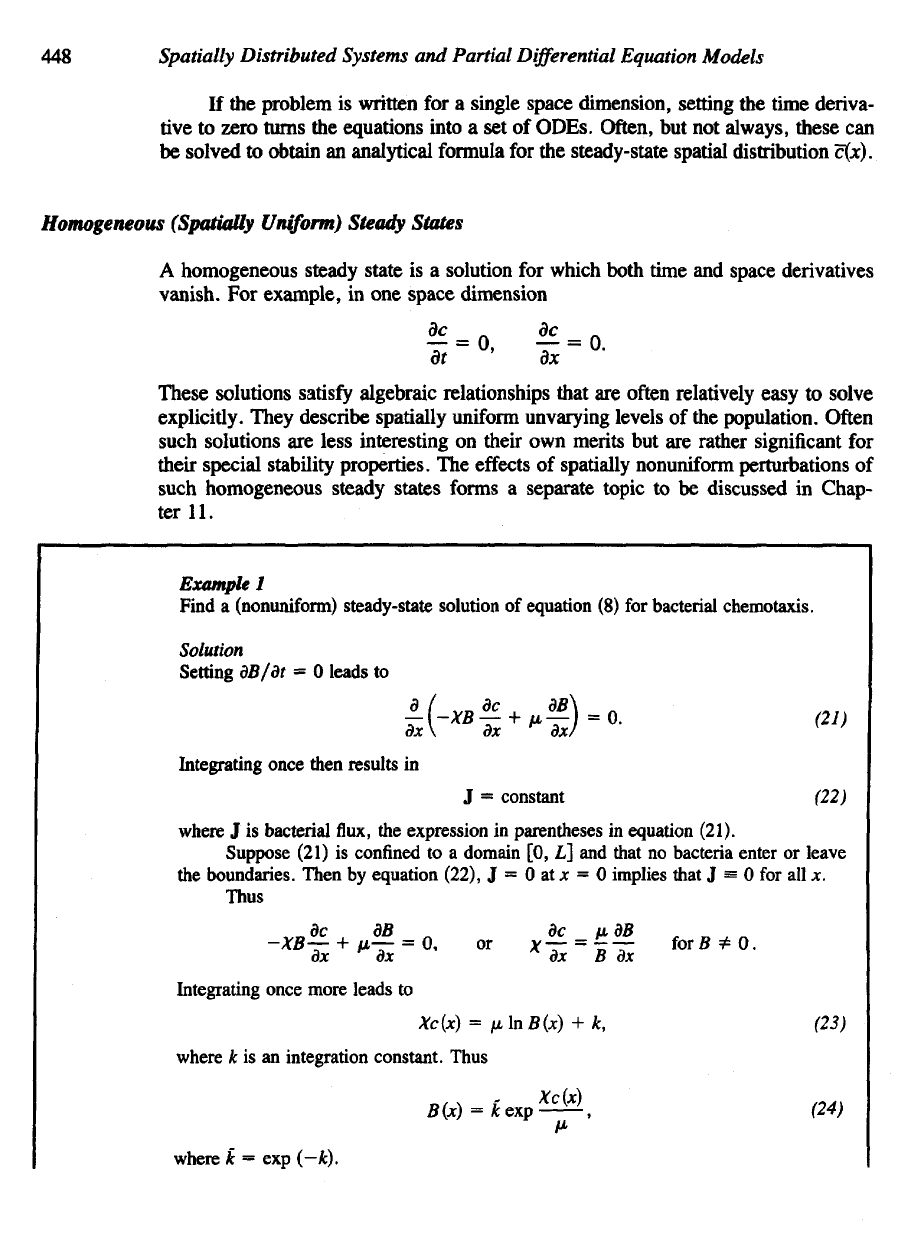
448
Spatially
Distributed
Systems
and
Partial
Differential
Equation
Models
If the
problem
is
written
for a
single space dimension, setting
the
time deriva-
tive
to
zero turns
the
equations into
a set of
ODEs.
Often,
but not
always, these
can
be
solved
to
obtain
an
analytical
formula
for the
steady-state spatial distribution
c(jc).
These solutions
satisfy
algebraic relationships that
are
often
relatively easy
to
solve
explicitly. They describe spatially
uniform
unvarying levels
of the
population.
Often
such
solutions
are
less interesting
on
their
own
merits
but are
rather
significant
for
their
special
stability properties.
The
effects
of
spatially
nonuniform
perturbations
of
such
homogeneous steady states
forms
a
separate topic
to be
discussed
in
Chap-
ter 11.
Homogeneous (Spatially
Uniform)
Steady
States
A
homogeneous steady state
is a
solution
for
which both
time and
space derivatives
vanish.
For
example,
in one
pace dimension
Example
1
Find
a
(nonuniform) steady-state solution
of
equation
(8) for
bacterial chemotaxis.
Solution
Setting
dB/dt
= to
where
J is
bacterial
flux, the
expression
in
parentheses
in
equation
(21).
Suppose
(21)
is
confined
to a
domain
[0, L] and
that
no
bacteria enter
or
leave
the
boundaries. Then
by
equation
(22),
J = 0 at x = 0
implies that
J = 0 for all x.
Thus
Integrating ce then results
in
Integrating
once more leads
to
where
k is an
integration stant. Thus
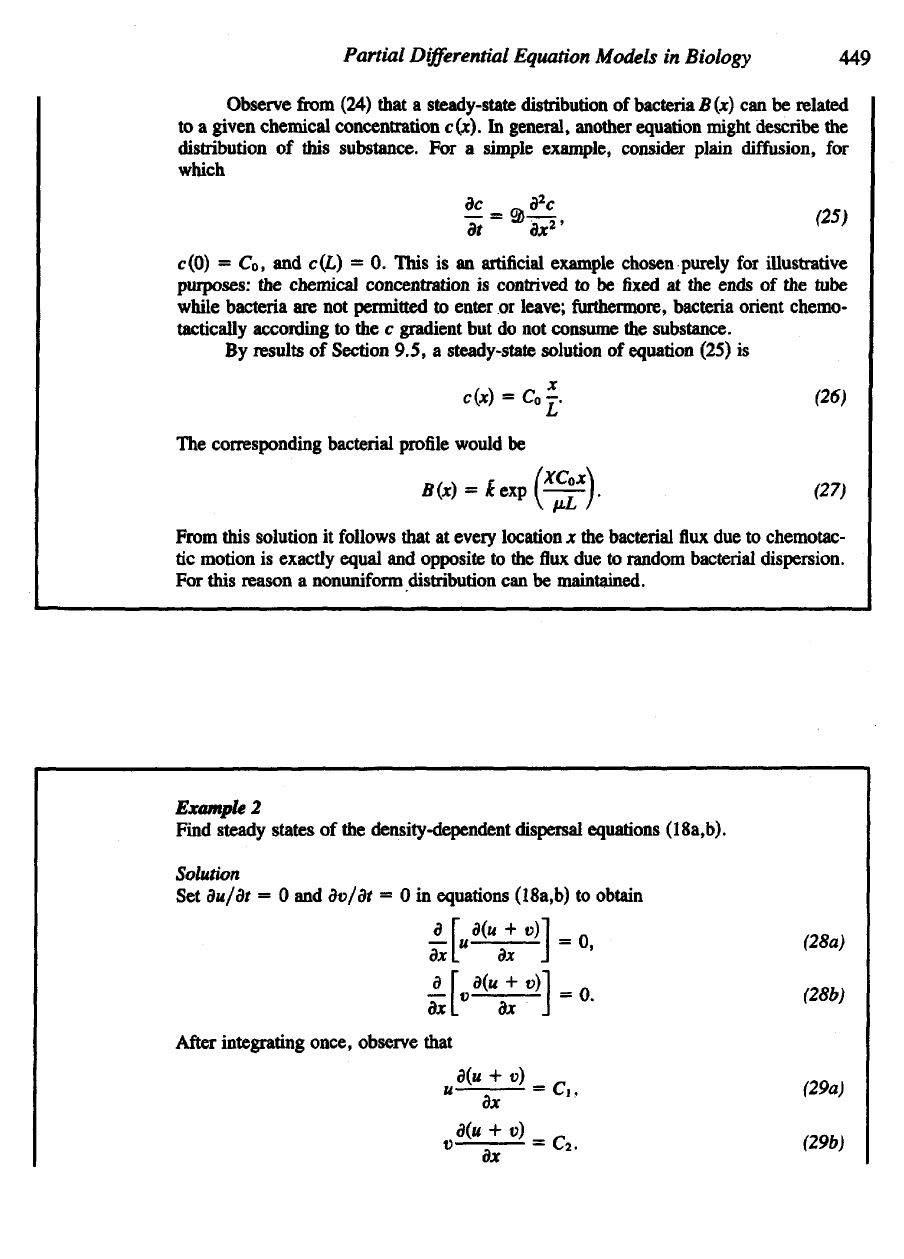
Partial
Differential
Equation Models
in
Biology
449
Observe
from
(24) that
a
steady-state distribution
of
bacteria
B (x) can be
related
to a
given chemical concentration c(x).
In
general, another equation might describe
the
distribution
of
this substance.
For a
simple example, consider plain
diffusion,
for
which
c(0)
= Co, and
c(L)
= 0.
This
is an
artificial
example chosen purely
for
illustrative
purposes:
the
chemical concentration
is
contrived
to be fixed at the
ends
of the
tube
while
bacteria
are not
permitted
to
enter
or
leave;
furthermore,
bacteria orient chemo-
tactically according
to the c
gradient
but do not
consume
the
substance.
By
results
of
Section 9.5,
a
steady-state solution
of
equation (25)
is
The
corresponding bacterial
profile
would
be
From
this solution
it
follows that
at
every location
x the
bacterial
flux due to
chemotac-
tic
motion
is
exactly equal
and
opposite
to the flux due to
random bacterial
dispersion.
For
this reason
a
nonuniform
distribution
can be
maintained.
Example
2
Find
steady states
of the
density-dependent dispersal equations (18a,b).
Solution
Set
du/dt
= 0 and
dv/Bt
= 0 in
equations (18a,b)
to
obtain
After
integrating once, observe that
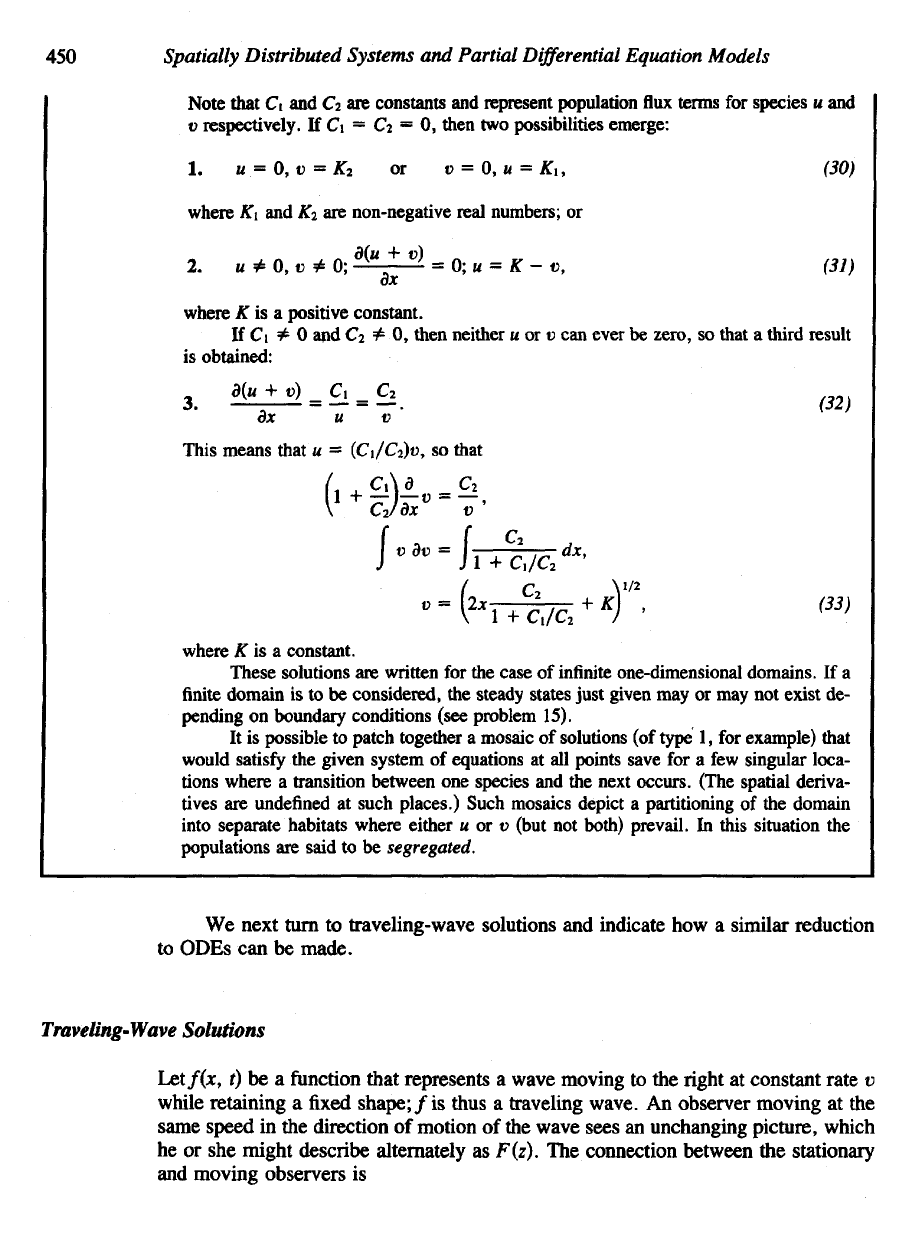
We
next
turn
to
traveling-wave
solutions
and
indicate
how a
similar
reduction
to
ODEs
can be
made.
Traveling-Wave
Solutions
Let f (x, t) be a
function
that
represents
a
wave
moving
to the right at
constant
rate
u
while
retaining
a fixed
shape;
f is
thus
a
traveling
wave.
An
observer
moving
at the
same
speed
in the
direction
of
motion
of the
wave
sees
an
unchanging
picture,
which
he
or she
might
describe
alternately
as
F(z).
The
connection
between
the
stationary
and
moving
observers
is
This means that
u =
(C1/C2)u,
so
that
where
K is a
constant.
These solutions
are
written
for the
case
of
infinite
one-dimensional domains.
If a
finite
domain
is to be
considered,
the
steady states just given
may or may not
exist
de-
pending
on
boundary conditions (see problem 15).
It is
possible
to
patch together
a
mosaic
of
solutions
(of
type
1, for
example)
that
would
satisfy
the
given system
of
equations
at all
points save
for a few
singular loca-
tions where
a
transition between
one
species
and the
next
occurs. (The spatial deriva-
tives
are
undefined
at
such places.) Such mosaics depict
a
partitioning
of the
domain
into separate habitats where either
u or v
(but
not
both) prevail.
In
this situation
the
populations
are
said
to be
segregated.
450
Spatially
Distributed
Systems
and
Partial
Differential
Equation
Models
Note that
Ci and C
2
are
constants
and represent
population
flux
terms
for
species
u and
v respectively. If C\ — €2 = 0,
then
two
possibilities
emerge:
where
Ki and K
2
are
non-negative real numbers;
or
where
K is a
positive constant.
If
Ci ^ 0 and C
2
!=•
0,
then neither
u or v can
ever
be
zero,
so
that
a
third result
is
obtained:
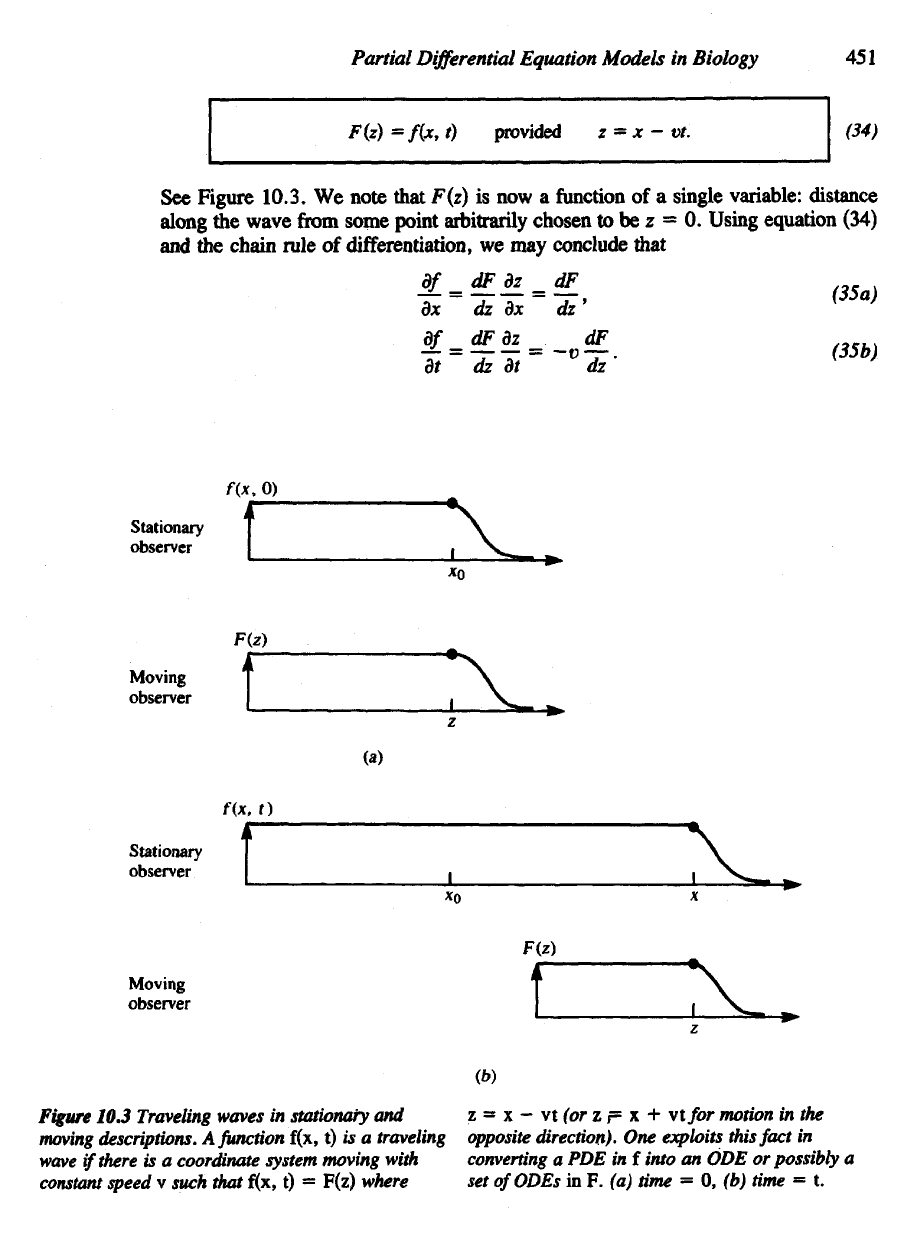
Partial
Differential
Equation
Models
in
Biology
451
See
Figure 10.3.
We
note that F(z)
is now a
function
of a
single variable: distance
along
the
wave
from
some point arbitrarily chosen
to be z = 0.
Using equation (34)
and
the
chain rule
of
differentiation,
we may
conclude that
Figure
10.3
Traveling waves
in
stationary
and
moving
descriptions.
A
function
f(x,
t) is a
traveling
wave
if
there
is a
coordinate system moving with
constant
speed
v
such that
f(x,
t) =
F(z)
where
z
= x
—
vt (or z p x +
\tfor
motion
in the
opposite
direction)-
One
exploits this fact
in
converting
a PDE in
f
into
an ODE or
possibly
a
set
ofODEs
in F. (a)
time
= 0, (b)
time
= t.

452
Spatially
Distributed
Systems
and
Partial
Differential
Equation
Models
Example
3
Consider
the
equation
If
we can find a way of
understanding this system
of
ODEs,
then
we can
make
a
statement about
the
existence
and
properties
of the
traveling-wave solutions. This
is our
main topic
in the
next section.
10.6 TRAVELING WAVES
IN
MICROORGAN EAD
OF
GENES
In
this section
we
describe
two
problems that
can be
approached
by
applying
famil-
iar
techniques
in a
rather novel way.
We first
deal with
a
classic model
due to
Fisher
that
illustrates ideas
in a
simple, clear setting.
A
second modeling problem
is
then
handled using similar methods.
Fisher's
Equation:
The
Spread
of
Genes
in a
Population
Fisher (1937) considered
a
population
of
individuals carrying
an
advantageous allele
(call
it a) of
some
gene
and
migrating randomly into
a
region
in
which only
the al-
lele
A is
initially present.
If p is the
frequency
of a in the
population
and q — 1
—
p
the
frequency
of A, it can be
shown that under Hardy-Weinberg genetics,
the
rate
of
change
of the
frequency
p at a
given location
is
governed
by the
equation
The
motivation
for
this equation
is
discussed
in the
next
section.
Letting
for
we
obtain
This
is a
second-order ODE.
We
shall convert
it to a
system
of first-order
ODEs
by
making
the
substitution
The
system
we
obtain
is
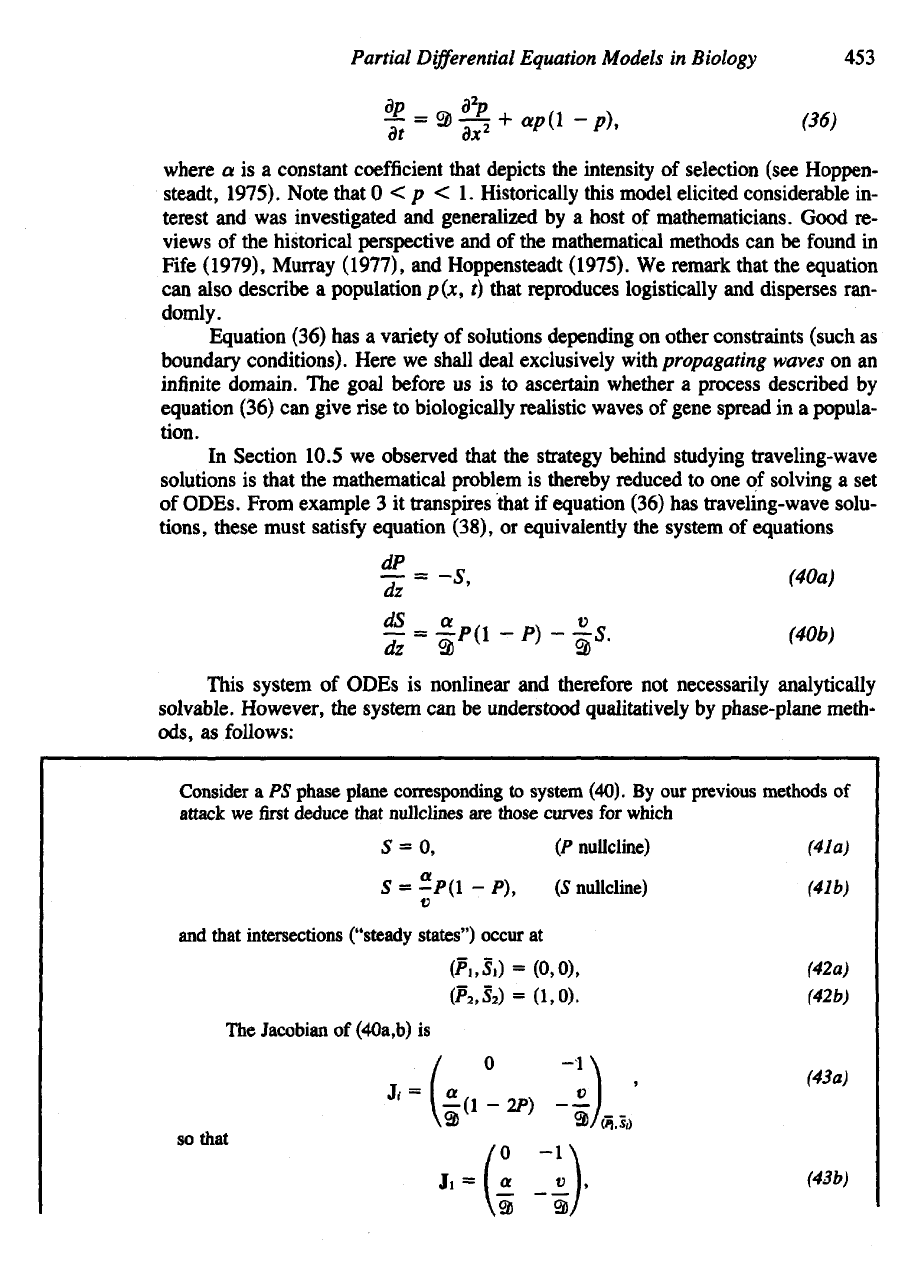
where
a is a
constant coefficient that depicts
the
intensity
of
selection (see Hoppen-
steadt, 1975). Note that
0 < p < 1.
Historically this model elicited considerable
in-
terest
and was
investigated
and
generalized
by a
host
of
mathematicians. Good
re-
views
of the
historical perspective
and of the
mathematical methods
can be
found
in
Fife
(1979), Murray (1977),
and
Hoppensteadt (1975).
We
remark that
the
equation
can
also describe
a
population
p
(A:,
t)
that reproduces logistically
and
disperses ran-
domly.
Equation (36)
has a
variety
of
solutions depending
on
other constraints (such
as
boundary
conditions). Here
we
shall deal exclusively with
propagating
waves
on an
infinite
domain.
The
goal before
us is to
ascertain whether
a
process described
by
equation (36)
can
give
rise to
biologically
realistic
waves
of
gene spread
in a
popula-
tion.
In
n 10.5
we
observed
that
the
strategy behind
studying
traveling-wave
solutions
is
that
the
mathematical problem
is
thereby reduced
to one of
solving
a set
of
ODEs. From example
3 it
transpires that
if
equation (36)
has
traveling-wave solu-
tions,
these
must
satisfy
equation (38),
or
equivalently
the
system
of
equations
Partial
Differential
Equation
Models
in
Biology
453
This system
of
ODEs
is
nonlinear
and
therefore
not
necessarily analytical!)
solvable. However,
the
system
can be
understood qualitatively
by
phase-plane
meth-
ods,
as
follows:
Consider
a PS
phase
plane
corresponding
to
system
(40).
By our
previous
methods
of
attack
we first
deduce
that
nullclines
are
those
curves
for
which
and
that
intersections
("steady
states")
occur
at
The
Jacobian
of
(40a,b)
is
so
that
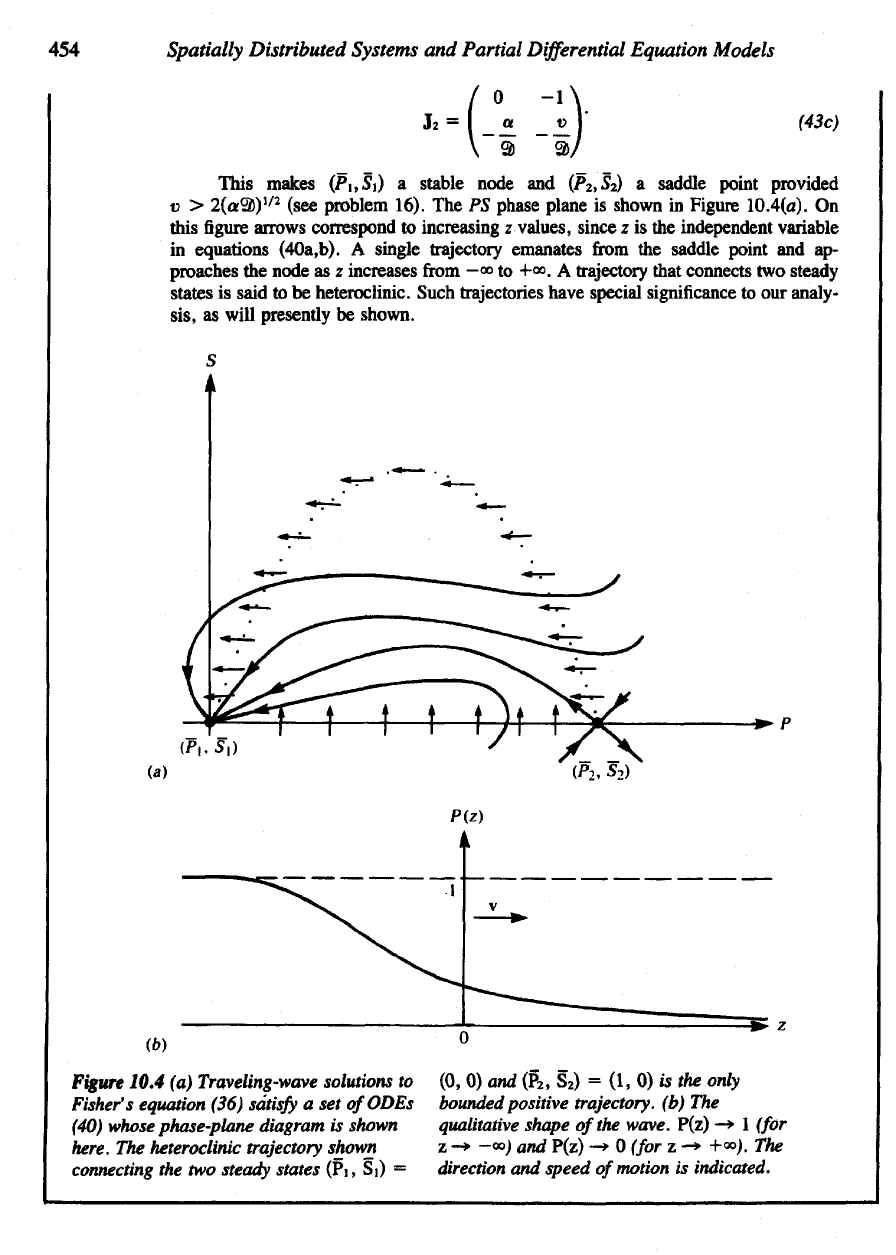
454
Spatially
Distributed
Systems
and
Partial
Differential
Equation
Models
es (P\,Si)
a
stable node
and
(P2,S
2
)
a
saddle point provided
v >
2(a2))
1/2
(see problem 16).
The PS
phase plane
is
shown
in
Figure
10.4(a).
On
this
figure
arrows correspond
to
increasing
z
values, since
z is the
independent variable
in
equations
(40a,b).
A
single trajectory emanates
from
the
saddle point
and ap-
proaches
the
node
as z
increases
from
—
°° to
+00.
A
trajectory that connects
two
steady
states
is
said
to be
heteroclinic. Such trajectories have special significance
to our
analy-
sis,
as
will presently
be
shown.
Figure
10.4
(a)
Traveling-wave solutions
to
Fisher's
equation (36)
satisfy
a set
ofODEs
(40)
whose phase-plane diagram
is
shown
here.
The
heteroclinic
trajectory
shown
connecting
the two
steady
states (P1,
S1) =
(0, 0) and
(P
2
,
S
2
) = (1, 0) is the
only
bounded
positive
trajectory,
(b) The
qualitative
shape
of
the
wave. P(z)
-* 1
(for
z
-»
-oo)
a
nd
P(z)
-» 0
(for
z -»
+°o).
The
direction
and
speed
of
motion
is
indicated.
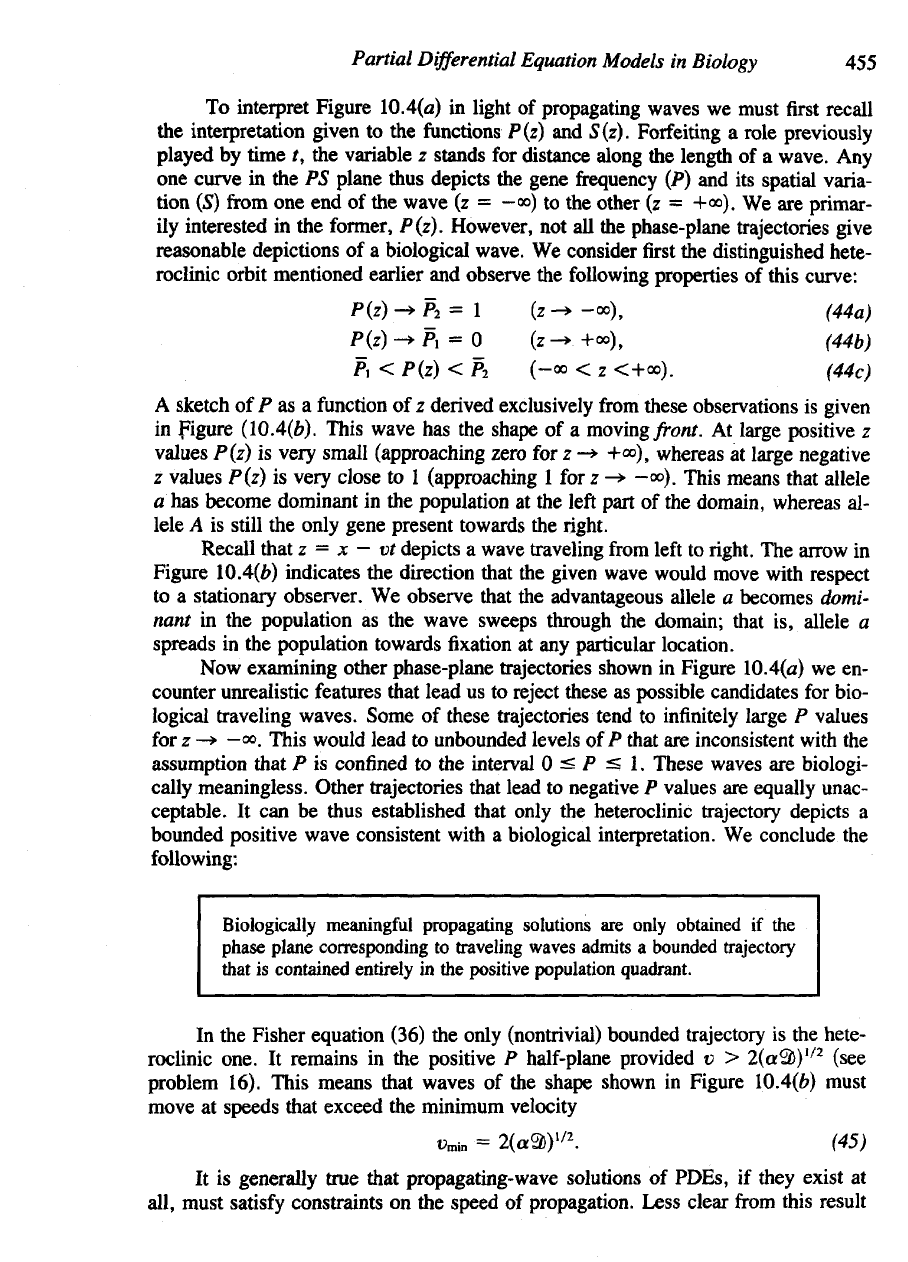
A
sketch
of P as a
function
of z
derived exclusively
from
these observations
is
given
in
Figure
(10.4(6).
This wave
has the
shape
of a
moving front.
At
large positive
z
values P(z)
is
very small (approaching zero
for z -»
+«>), whereas
at
large negative
z
values P(z)
is
very
close
to 1
(approaching
1 for z -»
-<»). This means that
allele
a has
become
dominant
in the
population
at the
left
part
of the
domain, whereas
al-
lele
A is
still
the
only gene present towards
the right.
Recall that
z = x - vt
depicts
a
wave traveling
from
left
to right. The
arrow
in
Figure 10.4(6) indicates
the
direction that
the
given wave would move with respect
to
a
stationary observer.
We
observe that
the
advantageous allele
a
becomes
domi-
nant
in the
population
as the
wave sweeps through
the
domain; that
is,
allele
a
spreads
in the
population towards
fixation at any
particular location.
Now
examining other phase-plane trajectories shown
in
Figure
10.4(<z)
we en-
counter unrealistic features that lead
us to
reject these
as
possible candidates
for
bio-
logical
traveling waves. Some
of
these trajectories tend
to
infinitely large
P
values
for
z -»
—oo.
This would lead
to
unbounded levels
of P
that
are
inconsistent with
the
assumption that
P is
confined
to the
interval
0 ^ P ^ 1.
These waves
are
biologi-
cally
meaningless.
Other trajectories that lead
to
negative
P
values
are
equally unac-
ceptable.
It can be
thus
established
that only
the
heteroclinic trajectory depicts
a
bounded
positive wave consistent with
a
biological interpretation.
We
conclude
the
following:
Biologically
meaningful propagating solutions
are
only obtained
if the
phase
plane
corresponding
to
traveling waves admits
a
bounded trajectory
that
is
contained
entirely
in the
positive
population quadrant.
In
the
Fisher equation (36)
the
only (nontrivial) bounded trajectory
is the
hete-
roclinic one.
It
remains
in the
positive
P
half-plane provided
v >
2(e*2))
1/2
(see
problem 16). This means that waves
of the
shape shown
in
Figure 10.4(6)
must
move
at
speeds that exceed
the
minimum v city
Partial
Differential
Equation
Models
in
Biology
55
To
interpret Figure
10.4(a)
in
light
of
propagating waves
we
must
first
recall
the
interpretation given
to the
functions P(z)
and
S(z). Forfeiting
a
role previously
played
by
time
t, the
variable
z
stands
for
distance along
the
length
of a
wave.
Any
one
curve
in the PS
plane thus depicts
the
gene
frequency
(P) and its
spatial varia-
tion
(S) from one end of the
wave
(z =
—
°°) to the
other
(z =
+<»).
We are
primar-
ily
interested
in the
former, P(z). However,
not all the
phase-plane trajectories give
reasonable depictions
of a
biological
wave.
We
consider
first the
distinguished hete-
roclinic
orbit mentioned
earlier
and
observe
the
following properties
of
this curve:
It is
generally true that propagating-wave solutions
of
PDEs,
if
they exist
at
all, must satisfy
constraints
on the
speed
of
propagation. Less clear
from
this result
